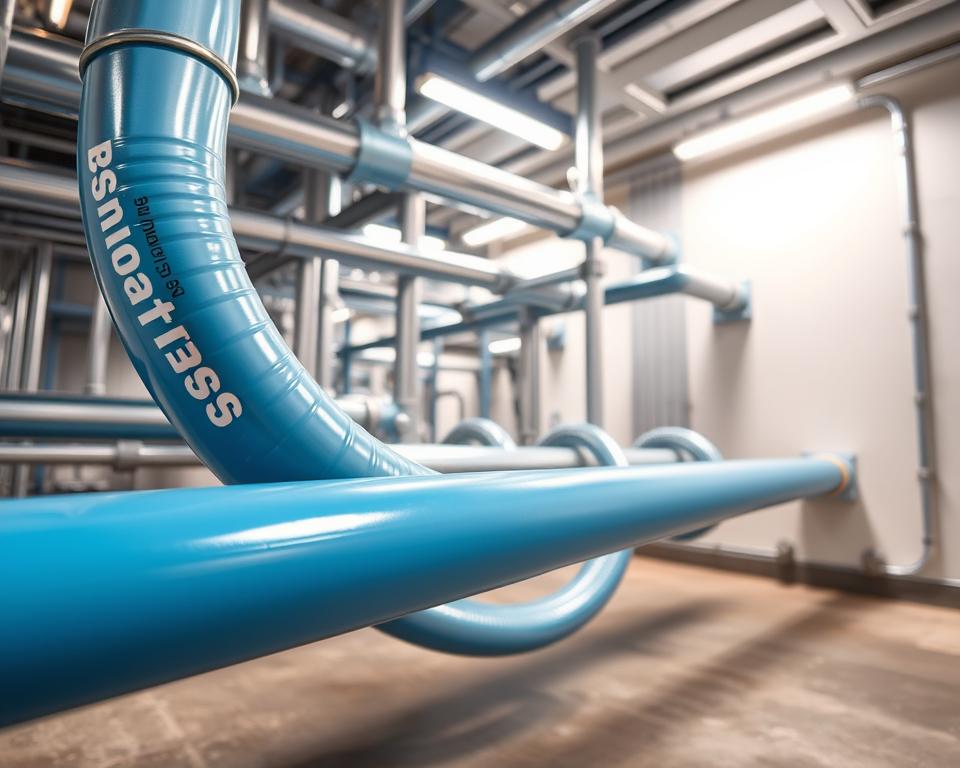PVC Pipe for Air Compressor Lines: Your Complete Guide
Did you know that a ruptured compressed air system can release energy equivalent to a stick of dynamite? Countless operations remain oblivious to the risks of certain piping systems they employ. This guide explains why safety should come first when using PVC air line.
Although some plastics gain popularity, OSHA flatly forbids their above-ground application. Over time, exposure to oils and temperature changes weakens them, leading to catastrophic failures. Even at “safe” pressure ratings, the risk of explosions remains high.
For reliable alternatives, Installation Parts Supply offers durable solutions like aluminum. Spending on the right materials prevents OSHA penalties and protects employees. Discover steps to construct a secure system.

Noteworthy Points
- OSHA prohibits specific piping for air lines because of blast hazards.
- Heat and cold swings slashes claimed pressure capacity.
- Material becomes brittle with age, upping rupture chances.
- Aluminum piping offers a safer alternative.
- Spending on correct materials avoids penalties and injuries.
Why PVC Pipe Is Dangerous for Compressed Air Systems
Manufacturers explicitly warn against using some plastics for high-energy applications. Compressed air carries destructive energy; a burst is like a dynamite blast. Material selection is the linchpin of air-system safety.
- Brittleness: Sub-freezing temperatures turn materials brittle, increasing fracture risks.
- Adhesive failures: Temperature changes and oils cause adhesive joints to fail.
- Misleading ratings: Ratings halve by 110°F, a common shop temperature.
OSHA cites a $110,000 fine after a facility’s piping shattered, injuring workers. Don’t forget, compression heat cuts into rated safety margins.
“Above-ground use of certain plastics for compressed air violates OSHA standards due to explosion risks.”
Steel and aluminum curve under stress instead of shattering. Plastic shrapnel from explosive failures can travel over 50 feet, embedding in walls or equipment.
Daily heat and cold cycles in a workshop degrade plastics rapidly. Over 10 years, UV exposure and chemical interactions further compromise integrity, turning minor leaks into major hazards.
Best Materials Instead of PVC for Air Lines
Modern aluminum systems beat old-school piping on both safety and performance. Black pipe vs. aluminum: aluminum wins with 90% fewer leaks. Their lightweight design and corrosion resistance make them ideal for long-term use.
Modular aluminum setups save time—no threading required. Installation Parts Supply stocks ready-to-snap aluminum modules. One auto factory trimmed labor hours by 40% via aluminum retrofits.
- Copper: Ideal in sterile environments for its germ-killing copper surface. Requires soldering expertise.
- Stainless Steel: In seaside shops, stainless steel won’t corrode.
- ABS/HDPE: For solvent-rich environments, ABS/HDPE stays intact.
“Our aluminum retrofit reduced energy waste by 15%—paying for itself in 18 months.”
Proper torque is critical. Too tight splits fittings; too loose lets air escape. Stick to recommended 25–30 ft-lb torque for aluminum.
For food-grade applications, NSF-certified options ensure air purity. Always match materials to your environment’s demands.
Selecting the Best Air Compressor Piping
Consider cost, compliance, and efficiency in your pipe decision. One plant slashed $12k per year by adopting aluminum lines. Follow these tips to pick wisely.
| Material | Cost (per ft) | Maintenance | ROI Time |
|---|---|---|---|
| Aluminum | $8.50 | Low | 18 months |
| Black Pipe | $5.00 | High | N/A |
| Copper | $10.20 | Medium | 24 months |
Watch your operating temperatures. Plastics fail under 32°F; aluminum works from -40°F to 200°F. For chemical-heavy environments, stainless steel resists solvents.
Pro Tip: Use leak-loss math to estimate ROI. A 10% air leak in 50 HP equals about $3,500 annually.
- Match PSI ratings to your compressor’s output.
- Check OSHA compliance for weld inspections and pressure tests.
- Contact Installation Parts Supply for a no-cost audit.
“Our aluminum retrofit cut energy waste by 15%—paying for itself in 18 months.”
Small shops can DIY, but experts deliver guaranteed seals. Always verify warranty terms—some materials cover 10+ years.
Conclusion
Safety outweighs sticker price in compressed-air piping. Older systems account for 92% of accidents due to degraded piping. With 99.8% uptime, aluminum is the clear long-term choice.
Key takeaways:
- Never use pipes that can fragment violently.
- Metallic lines beat plastics on both safety and durability.
- Non-compliant systems risk OSHA fines and insurance issues.
Ready to upgrade? Get instant quotes and special offers from Installation Parts Supply. Request your free template or emergency service today.
Make safety your piping priority—act today.

